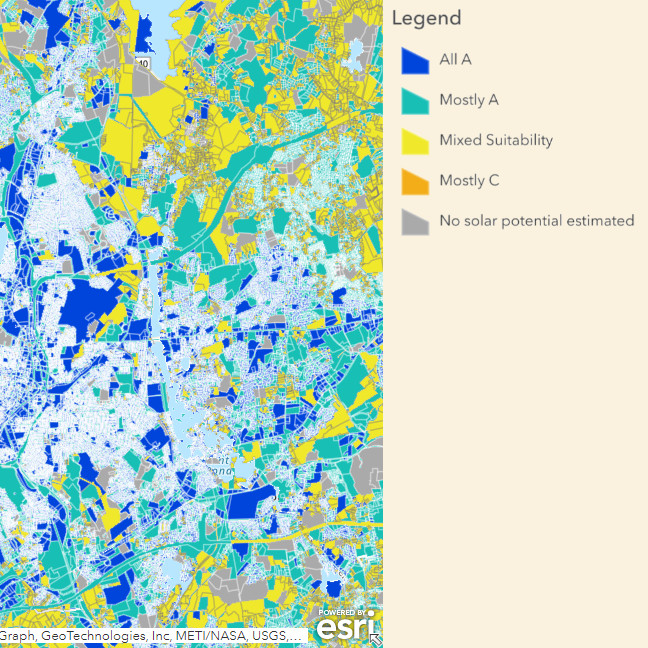New State Study and Map Show Best Spots in State for Solar Panels
. Posted in News - 0 Comments
By Kimberly Rau, MassLandlords, Inc.
A new study from the state Department of Energy Resources shows that the state has ample land for solar panels, which is good news for a state that needs to make big leaps in solar capacity in the next seven years.

The Massachusetts Technical Potential of Solar map shows how your lot or lots stack up. (Image License: Public Domain)
Massachusetts must have between 27 and 34 gigawatts of solar capacity by 2030 to meet its energy goals as outlined in its Clean Energy and Climate Plan of 2025 and 2030. Currently, the state has approximately 3 gigawatts of solar installed.
The Technical Potential of Solar Study examined land throughout the state and rated its suitability for rooftop solar panels, solar canopies (panels mounted to canopies over parking lots and similar infrastructure) and ground panels. Though there is room for more than 500 gigawatts of solar energy in Massachusetts, only around 50 gigawatts are top-rated, scoring well among the six criteria the study used to determine suitability.
The Six Factors for Solar Suitability
The study looked at each parcel of land in Massachusetts and rated them for solar use based on six factors. Whether a property turned out to be well-suited for solar was based on how well the plot did across all six categories.
The study looked at the following factors: 1) agriculture: whether the land is farmland or is known to have prime agricultural soil; 2) biodiversity: if the parcel is important to maintaining biological diversity of various species; 3) ecosystem: whether the land is designated wetlands, or other areas of “critical environmental concern”; 4) embedded carbon dioxide (CO2e): this measures how much carbon dioxide would be emitted by building on the land, and estimates how much carbon dioxide sequestration would be lost by building on the land; 5) electric infrastructure: whether the land is near an electric grid that could support solar panels, or how easily it could be put on the grid; and 6) slope and aspect: whether the land and included terrain are well-suited to some kind of solar panel construction.
The result was a range of ranking for plots of land based on all six factors.
How to Use the Solar Map to Determine Whether Your Property is Good for Solar
To look at your plot of land, head to the interactive solar map site. You can look at the main map to see the overall suitability of your plot, or select one of six suitability maps to see how your plot rates for each of the six metrics the study focused on. Enter your address into the search bar on the map, and you will be taken to your plot of land. You can zoom out to get a better view of your whole neighborhood, city or county, or take in the entire state at once.
Some parcels will be gray; these are plots of land that the state has determined are not suitable for solar. This could be due to the plot of land being protected from development.
The study makes clear that the information found on the solar map is not meant to be a recommendation to install solar panels. There are many factors not considered in the study that should play into your decision. For instance, your plot of land may be rated highly suitable, but your roof may not be properly sloped for panels. Or, your lot could be considered highly suitable, but if your neighbors have a bunch of tall trees, that’s not going to be ideal after all.
However, the map is an excellent first step if you are still trying to decide whether solar is right for you. There are a bunch of environmental benefits to using solar energy, and there are a lot of tax benefits and energy savings to be had (though if you lease your panels instead of buying them, typically, the leasing company is going to reap those tax benefits, not you). For your rental properties, you may still be able to make use of the state SMART program. Though most blocks have sold out at this point, you can check and see if any incentives are available for your region. The caveat here is the SMART program can be tricky, so you will need a solar expert to make sure you’re doing everything by the book.
You may also indirectly charge your tenants to offset some of the costs of the solar panels you install on your rentals. They get free electricity, you recoup some of your overhead. And MassSave is currently incentivizing solar batteries. Solar batteries are optional add-ons that allow panel owners to store accrued energy and sell it back to the grid during peak times.
Conclusion
Massachusetts’ journey to its solar energy goals is a long road, but this study and the accompanying solar map are great tools for developers to determine where, and how, additional solar panels can be placed throughout the state. It’s also a useful tool for homeowners who are considering solar energy for their properties.
Have you installed solar energy on your rental properties? If you’d like to share your experience, email us at hello@masslandlords.net.




